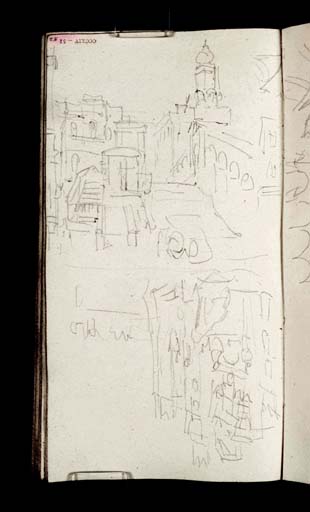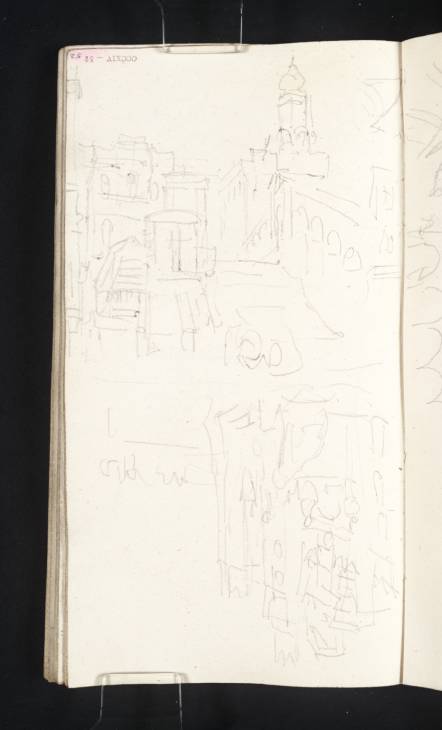Joseph Mallord William Turner The Rialto Bridge, Venice, with the Campanile of San Bartolomeo; the Piraeus Lion Statue beside the Porta Magna Entrance to the Arsenale 1833
Image 1 of 2
-
 Joseph Mallord William Turner, The Rialto Bridge, Venice, with the Campanile of San Bartolomeo; the Piraeus Lion Statue beside the Porta Magna Entrance to the Arsenale 1833
Joseph Mallord William Turner, The Rialto Bridge, Venice, with the Campanile of San Bartolomeo; the Piraeus Lion Statue beside the Porta Magna Entrance to the Arsenale 1833 -
 Joseph Mallord William Turner, The Rialto Bridge, Venice, with the Campanile of San Bartolomeo; the Piraeus Lion Statue beside the Porta Magna Entrance to the Arsenale 1833 (Enhanced image)Enhanced image
Joseph Mallord William Turner, The Rialto Bridge, Venice, with the Campanile of San Bartolomeo; the Piraeus Lion Statue beside the Porta Magna Entrance to the Arsenale 1833 (Enhanced image)Enhanced image
Joseph Mallord William Turner,
The Rialto Bridge, Venice, with the Campanile of San Bartolomeo; the Piraeus Lion Statue beside the Porta Magna Entrance to the Arsenale
1833
Joseph Mallord William Turner 1775–1851
Folio 52 Recto:
The Rialto Bridge, Venice, with the Campanile of San Bartolomeo; the Piraeus Lion Statue beside the Porta Magna Entrance to the Arsenale 1833
D32027
Turner Bequest CCCXIV 52
Turner Bequest CCCXIV 52
Pencil on white laid paper, 203 x 109 mm
Partial watermark ‘C G’ (countermark)
Inscribed by C.F. Bell in black ink ‘52’ top left, upside down
Stamped in black ‘CCCXIV – 52’ top left, upside down
Partial watermark ‘C G’ (countermark)
Inscribed by C.F. Bell in black ink ‘52’ top left, upside down
Stamped in black ‘CCCXIV – 52’ top left, upside down
Accepted by the nation as part of the Turner Bequest 1856
References
1909
A.J. Finberg, A Complete Inventory of the Drawings of the Turner Bequest, London 1909, vol.II, p.1014, CCCXIV 52, as ‘View from bridge, &c.’.
The Turner scholar C.F. Bell annotated Finberg’s 1909 Inventory entry (‘View from bridge, &c.’): ‘The Rialto from near the Erberia’.1 The page’s title was amended by Ian Warrell to ‘The Entrance to the Arsenale, with One of the Lion Statues; the Rialto Bridge, with the Campanile of San Bartolomeo’ in 2003, in connection with his concurrent Turner and Venice exhibition at Tate Britain.2 The page was used vertically, both ways up, for two unrelated subjects.
Inverted Relative to the foliation, the slightly more detailed view is from the north-west end of the Rialto Bridge, looking up the central steps between its arcades to the soaring campanile of San Bartolomeo, just beyond the south side of the Grand Canal. The southern corner of the Palazzo Camerlenghi is introduced at the left-hand edge. There is a view in this direction from further back on folio 51 recto (D32025), and a prospect of the bridge from the canal on folio 49 verso (D32022). As well as frequently depicting the well-known structure from the water, Turner tried more innovative ways of showing its complex geometry; compare views from the foot of the opposite side in the 1819 Venice to Ancona sketchbook (Tate D14511–D14512; Turner Bequest CLXXVI 12a–13), and from the top, looking back in this direction, in the 1840 Rotterdam to Venice book (D32415; CCCXX 78).
As Warrell noted, the other subject is at the entrance to the Arsenale dockyards, towards the eastern end of the city. The elaborate Renaissance stonework of the Porta Magna gateway is shown obliquely on the left, facing south over the Campo Arsenale, with loose indications of the four classical statues on pillars in front of it and the twin towers flanking the Rio dell’Arsenale entrance to the complex beyond. In the foreground is the cursory outline of a large ancient Greek stone statue of a seated lion, taken from the harbour of Athens, Piraeus, by which it is generally known. It is the largest of four stone lions flanking the gateway; the others, in various sizes, styles and postures are on the far side of the Porta Magna towards the canal, and not shown here. The animal is commonly represented in winged form in the city’s monumental architecture as the symbol of the its patron saint, St Mark.
The Piraeus lion is seen in a detailed view of the square in the 1819 Milan to Venice sketchbook (Tate D14419; Turner Bequest CLXXV 55), below the winged lion over the Porta Magna; there is also a general view from along the canal in the present book (folio 73 recto; D32063), under which the subject is discussed further, and the towers are fortuitously seen to the east in the distance on folio 71 verso (D32061).
At the top right of the Rialto view is a slight continuation from the unrelated horizontal study inside the basilica of San Marco (St Mark’s) on folio 51 verso opposite (D32026). That drawing is, rather awkwardly, continued downwards on the verso of the present leaf (D32028), suggesting that the present page had already been used for at least one of its subjects. For this sketchbook’s somewhat convoluted general sequence, see its Introduction.
Matthew Imms
May 2019
How to cite
Matthew Imms, ‘The Rialto Bridge, Venice, with the Campanile of San Bartolomeo; the Piraeus Lion Statue beside the Porta Magna Entrance to the Arsenale 1833 by Joseph Mallord William Turner’, catalogue entry, May 2019, in David Blayney Brown (ed.), J.M.W. Turner: Sketchbooks, Drawings and Watercolours, Tate Research Publication, March 2023, https://www

